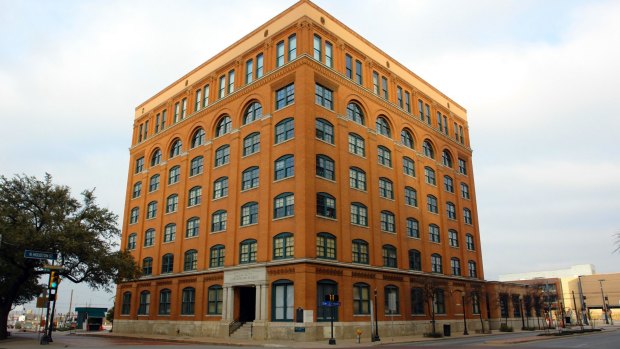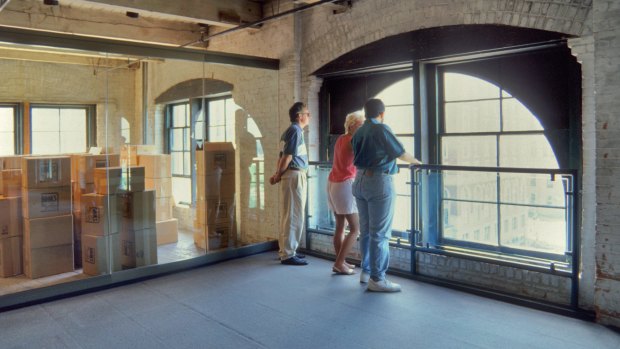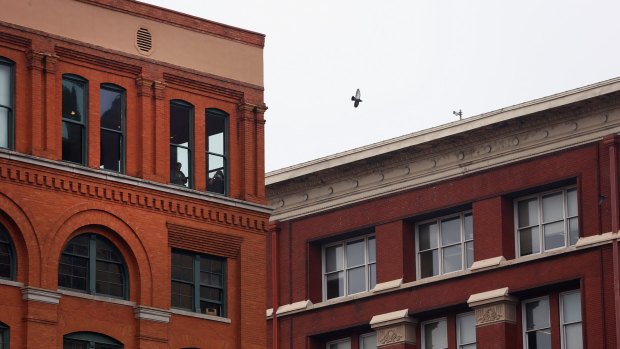This was published 1 year ago
Sixth Floor Museum, Dallas: Time stands still at the site where Lee-Harvey Oswald shot John F. Kennedy
By Mark Hofmeyer

The red brick, seven-storey building is now known as the the Dallas County Administration Building.Credit: iStock
Staring down from the sixth-floor window of the former Texas School Book Depository, it would be next to impossible to accurately fire two shots into a moving car on the roadway at Dealey Plaza below. In 2022, a flourishing elm tree obscures the view as the road sweeps around and down towards the rail underpass. But the third shot? Well, the line of sight for that one remains as clear as it would have been that day, back in November 1963.
The view is halfway through the exhibit, known as the Sixth Floor Museum. It's a moment re-created to appear as if the assassination of a president caused time to stand still. Boxes of books, stacked carefully in the corner to create a sniper's nest, with a single box angled at the corner window to be the resting point for the Carcano Model 38 rifle, complete with telescopic sight, that Lee-Harvey Oswald used to fire those three shots.
Clear glass encases the spot from where Oswald took aim, but visitors can stand at the window immediately adjacent to it and gaze past that burgeoning elm tree which has, for 60 years, seen countless others contemplate how Oswald changed history.

Clear glass encases the spot from where Oswald took aim, but visitors can stand at the window immediately adjacent to it..Credit: Alamy
Like the view, the red brick, seven-storey building sitting on the northern side of the plaza remains almost the same, other than the missing Hertz sign on top, and a new name: the Dallas County Administration Building. Inside, the low ceiling marked by large wooden beams preserves the look and feel of the dimly-lit space. The path of the museum snakes through exhibits chronicling all aspects of the assassination of JFK on November 22, 1963, but also the political landscape that led up to it.
One display names at least nine groups believed to have wanted President John F Kennedy dead, but anyone looking for definitive proof that Lee Harvey Oswald acted alone won't find it here. In terms of who exactly planned the killing, how and why, the museum leaves visitors guessing.
Apart from the conspiracy theories, the museum also allows for the consideration of "what if?". Surveys of Americans even into the mid-90s still ranked JFK as one of the greatest US Presidents, despite just 22 months in office.

The line of sight for that one remains as clear as it would have been that day, back in November 1963.Credit: Getty Images
After the assassination, President Lyndon B. Johnson shepherded more than 30 Kennedy bills through the House and Senate to become law, including civil rights legislation and the Mass Transportation Act. Books, movies and essays have all speculated on a future if Oswald had missed.
But he didn't. And now tourists scramble onto the busy roadway between traffic light sequences to take a photo of the three large white crosses marked on the road, which signify the three rifle shots fired at the presidential motorcade.
Eyes are cast towards that sixth-floor corner window, to assess the precision of the shots towards a moving vehicle. Swing around, and there's the grassy knoll, a short hill topped by a wooden picket fence that has been rebuilt numerous times to ensure it looks the same as it did on the day JFK was killed.
Behind that, a parking lot, from where conspiracy theorists claim a second gunman fired the fatal shot and then fled in a waiting car.
Most chilling of all is to stand where Abraham Zapruder captured the images of the assassination on his Bell & Howell 44PD Zoomatic camera. Frame 312 of his movie reel captures the moment the fatal shot hit America's 35th president.
The movie isn't played in the Sixth Floor Museum, where only still images are displayed. It does, however, feature the stark vision of Oswald's death, taken from an era when live television was in its infancy.
Local nightclub owner Jack Ruby shoots him at the police watchhouse and in the chaotic scenes that follow, Oswald is dumped onto a medical gurney and thrown into the back of an ambulance. It is particularly confronting to see now, knowing that he would be taking his secrets to the grave.
Trains still rumble past on the bridge just 150 metres along from where the third shot struck President Kennedy. Just a few more seconds and his motorcade would have entered the underpass and been clear of the shooter.
An old man sitting nearby is spruiking his version of the conspiracy theory and selling books and videos about the assassination to anyone who'll listen. And then the traffic light flicks green and the white crosses disappear under the stream of Wednesday peak hour traffic. Because time didn't actually stop that day in 1963, after all.
The Sixth Floor Museum is located in the West End Historic District on the corner of North Houston and Elm Streets. The museum is open Wednesday to Sunday 10am-5pm. Tickets can only be purchased online at www.jfk.org and cost $US18 for adults, $US16 for seniors and $US14 for children aged 6-18 years.
Sign up for the Traveller Deals newsletter
Get exclusive travel deals delivered straight to your inbox. Sign up now.